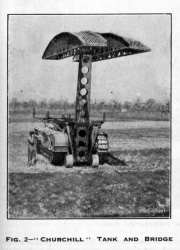Churchill Tank
The Tank, Infantry, Mk IV (A22) was a heavy British infantry tank used in the Second World War, best known for its heavy armour and its use as the basis of many specialist vehicles.
Initially specified prior to the outbreak of the Second World War the (A20) was to be the replacement for the Matilda II and Valentine. In accord with British Infantry Tank doctrine and based on the expected needs of World War I style trench warfare, the tank was required to be capable of navigating shell cratered ground, demolishing infantry obstacles (such as barbed wire) and attacking fixed enemy defences; for these purposes, great speed and heavy armament was not required.
The task of design and construction of the A20 was given to Harland and Wolff, who by June of 1940 had completed four prototypes. The vehicle was armed with two 2-pounder guns each located in a side sponson and plans existed for an additional third gun in a central turret. The A20 designs were short-lived however, as at roughly the same time the emergency evacuation of the British Expeditionary Force from Dunkirk occurred. With France conquered, the scenario of trench warfare was no longer applicable and the specifications were revised by Dr. H.E. Merritt, director of Tank Design, based on the combat witnessed in Poland and France. These new specifications, the (A22) or Infantry Tank Mark IV, were given to Vauxhall.
With German invasion looking imminent and the United Kingdom having lost most of its military vehicles in the evacuation from France, the War Office specified that the A22 must begin production within the year. By July 1940 the design was complete and by December of that year the first prototypes were completed; it was in June 1941, almost exactly a year as specified, that the first Churchill tanks began rolling off the production line.
There had been little in the way of testing and the Churchill was plagued with mechanical faults. Most apparent was the Churchill's underpowered and unreliable engine, a situation made far worse by the engine's lack of accessibility. Another serious shortcoming of the tank was its weak armament, the 2 pounder 40 millimetre gun, which was somewhat fixed by the addition of a 3 inch howitzer in the hull (the Mk IICS had the howitzer in the turret) to deliver an HE shell albeit not on howitzer type trajectories. These flaws contributed to the tank's poor performance in its first combat outing, the disastrous Dieppe Raid in August, 1942.
The success of the Churchill was greatly advanced by the emergence of the much improved Mk III which appeared in March, 1942 and first saw operational use during the Dieppe Raid (Operation Jubilee) on 19 August 1942.[1]
In the Tunisia and Italian campaigns, the Mk III and its immediate successors continued to prove their usefulness. Among numerous mechanical fixes, the Mk III was distinct for removing the previous weapons of the Churchill and utilizing the 6 pounder gun (57 millimetre) in a new turret design. In one encounter the updated Churchill tank even eliminated a heavy German Tiger I tank, the 'kill' was achieved by the 6-pdr shot becoming lodged in between the Tigers turret and turret ring, the crew abandoned the Tiger tank, which was subsequently captured by the British. This particular tank is on display at Bovington Tank Museum in the United Kingdom.
The second major improvement in the Churchill's design, the Mk VII first saw operational use in the Battle of Normandy in 1944. The Mk VII improved on the already heavy armour of the Churchill with a wider chassis and the 75 mm gun which had been introduced on the Mk VI. It was primarily this variant, the A22F, which served through the remainder of war and was redesignated as A42 in 1945.
The Churchill was also quite notable for its versatility and was utilized in numerous specialist roles. Additionally, in tests conducted in the Madang by the Australian Army in mid-1944, at the request of the British War Office, the Churchill was tested against the M4 Sherman and found it to be, overall, a superior tank for jungle warfare.
The Soviet Union received a total of 301 of Churchill Mk.III and Mk.IV types as part of the Lend-Lease program.
The tank remained in the service of the British Army until 1952 with one (a bridgelayer) remaining in service well into the 1970s.
The Irish Army took delivery of four Churchill Mk VI tanks in 1948. They were rented from the British War Office as trials vehicles until 1954, when they were purchased outright. This purchase was despite the fact that the supply and transport corps workshops, who maintained them, had reported that spares had all but run out. Experiments were carried out involving replacing the existing Bedford engine with a Rolls Royce Merlin engine salvaged from an Air Corps Seafire. The experiment was not a success, although the reasons are not recorded. By 1967 only one Churchill remained serviceable, and by 1969 all were retired. One remains preserved in the Curragh Camp. The Churchill was an unusual choice for the Irish Army, as the most of the country at that time consisted of narrow roads and small fields with hedges and ditches restricting movements by armoured vehicles. In general, the Army has always relied upon lighter, more maneuverable armoured vehicles, such as the Panhard AML and FV101 Scorpion of modern times.
See Also
Sources of Information
- ↑ Gwyn Evans
- [1] Wikipedia





